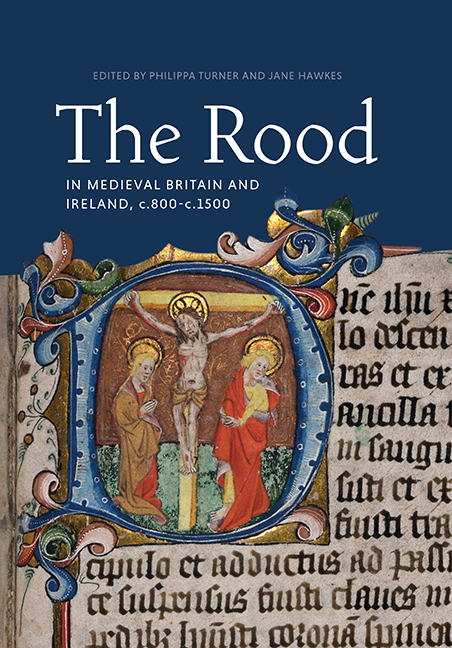Book contents
- Frontmatter
- Contents
- List of Illustrations
- List of Contributors
- Acknowledgements
- List of Abbreviations
- 1 Introduction: Rethinking the Rood
- 2 Approaching the Cross: The Sculpted High Crosses of Anglo-Saxon England
- 3 The Mark of Christ in Wood, Grass and Field: Open-Air Roods in Old English Medical Remedies
- 4 Twelfth-Century English Rood Visions: Some Iconographic Notes
- 5 Crosses, Croziers and the Crucifixion: Twelfth-Century Crosses in Ireland
- 6 From Religious Artefacts to Symbols of Identity: The Role of Stone Crosses in Galician National Discourse
- 7 The Rood in the Late Medieval English Cathedral: The Black Rood of Scotland Reassessed
- 8 The Cross of Death and the Tree of Life: Franciscan Ideologies in Late Medieval Ireland
- 9 Heralding the Rood: Colour Convention and Material Hierarchies on Late Medieval English Rood Screens
- 10 Reframing the Rood: Fifteenth-Century Angel Roofs and the Rood in East Anglia
- Bibliography
- Index
- Already Published
- Plate Section
6 - From Religious Artefacts to Symbols of Identity: The Role of Stone Crosses in Galician National Discourse
Published online by Cambridge University Press: 07 November 2020
- Frontmatter
- Contents
- List of Illustrations
- List of Contributors
- Acknowledgements
- List of Abbreviations
- 1 Introduction: Rethinking the Rood
- 2 Approaching the Cross: The Sculpted High Crosses of Anglo-Saxon England
- 3 The Mark of Christ in Wood, Grass and Field: Open-Air Roods in Old English Medical Remedies
- 4 Twelfth-Century English Rood Visions: Some Iconographic Notes
- 5 Crosses, Croziers and the Crucifixion: Twelfth-Century Crosses in Ireland
- 6 From Religious Artefacts to Symbols of Identity: The Role of Stone Crosses in Galician National Discourse
- 7 The Rood in the Late Medieval English Cathedral: The Black Rood of Scotland Reassessed
- 8 The Cross of Death and the Tree of Life: Franciscan Ideologies in Late Medieval Ireland
- 9 Heralding the Rood: Colour Convention and Material Hierarchies on Late Medieval English Rood Screens
- 10 Reframing the Rood: Fifteenth-Century Angel Roofs and the Rood in East Anglia
- Bibliography
- Index
- Already Published
- Plate Section
Summary
It was towards the end of the Middle Ages that figural stone cross-heads set upon pillars were developed in Galicia, a region located on the north-west of the Iberian Peninsula. These are known as cruceiros, the Galician word for stone crosses, which are usually composed of a pedestal, a shaft and a cross (Fig. 6.1). Erected from the fourteenth century onwards, these monuments are often identified as a key part of Galician cultural identity. This is primarily because of their abundance in the Galician landscape in comparison with other regions in the Peninsula, which resulted in their playing a role in the discursive construction of Galician national identity at the beginning of the twentieth century.
Scholarly research on stone crosses as a means to define a cultural identity was first carried out in Ireland where one of its main exponents was Henry O’Neill, author of Illustrations of the Most Interesting of the Sculptured Crosses of Ancient Ireland (1857). He was part of a larger group of scholars and antiquarians in Ireland who sought to promote the country's long-standing cultural identity. His studies on Irish high crosses presented them as a native production, in line with his understanding of Irish art as an expression of a national character, showing Ireland as a nation with its own indigenous artistic culture. In Galicia, although at a later date, the identification of these monuments as part of its cultural and national identity was also the initial point of enquiry, with Alfonso Daniel Rodríguez Castelao's work published in his two books: As cruces de pedra na Bretaña (1930) and As cruces de pedra na Galiza (1950).
The main focus of the present volume is on crosses produced within the context of Britain and Ireland, so my discussion will not involve any exhaustive analysis of these works. However, it is necessary to look briefly at their functions and iconographic programmes, both of which have been analysed in prior scholarship in this field. Thus, this discussion will begin by considering the free-standing stone crosses developed in the Insular world between the seventh and twelfth centuries as well as those produced during the later Middle Ages.
- Type
- Chapter
- Information
- The Rood in Medieval Britain and Ireland, c.800-c.1500 , pp. 81 - 102Publisher: Boydell & BrewerPrint publication year: 2020

